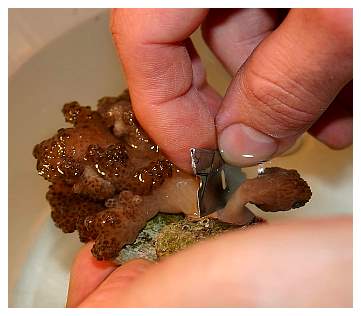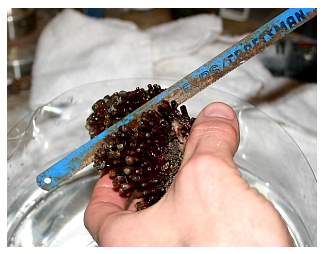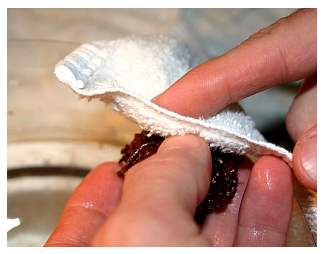|
Propagation of Colt and Organ
Pipe Corals
Propagating Colt or Klyxum Genus Corals
|
Colt (Klyxum) corals can grow quickly in a well-lit
aquarium but, unfortunately, propagating corals of this
genus can be challenging.
|
Colt or Klyxum
corals (previously described in the literature as Cladiella)
are extremely soft and somewhat slimy to the touch. Colt coral
is prone to microbial infections during propagation efforts.
Sections of coral can be cut with a razor blade or scissors
and can be placed into small cups partially filled with gravel
or small rocks. The cups have to be covered sufficiently with
some type of plastic netting, or placed in an area with low
current so that the cuttings do not become dislodged. It can
take several weeks or more for colt cuttings to attach sufficiently
to the gravel before they can be handled again. Once they
have reached this point, the gravel pieces attached to the
coral can be dried with a paper towel, and gel type cyanoacrylate
glue can be used to attach them to a large rock in a manner
similar to that described in last month's article
on propagation of small-polyped stony corals. Unfortunately,
colt corals propagated in this manner still sometimes detach
and blow away in the current. Also, the low flow conditions
necessary in the gravel cup to allow the coral to attach to
the gravel are very conducive to microbial growth on the damaged
tissue, which can turn the coral into a pile of mush in a
matter of days.
 |
|
Starting at the separate lobe, a cut is made straight
through the colony down to the base rock.
|
Though somewhat time consuming, another propagation method
that I have tried with colt corals is the "sewing"
method. The coral's tissue is pierced in multiple locations
and then very gently tied onto a substrate using thin fishing
line or nylon thread. Unfortunately, colt corals have a tendency
to pull away from any materials that are imbedded in their
tissue, and often pull away from the thread before they can
successfully attach to the substrate. This method can work
with some corals that have a high density of sclerites (small
calcium carbonate skeletal elements that help a soft coral
maintain its shape) in their tissues, such as those covered
in a previous propagation article,
but rarely works on a coral with low densities of sclerites,
such as colt corals.
|
The section of rock that the fragment is attached to
is cut free from the large rock.
|
The
next day the fragment is starting to heal. It could
be glued to a larger rock, if desired.
|
I've largely abandoned the "cup" and "sewing"
methods for colt coral propagation, as I've found them far
too time consuming and prone to failure. Instead, I use a
sharp razor blade to cut a lobe of the coral down to the base
rock to which it is attached. I then cut the coral completely
free from the main rock by cutting through the rock using
a high-speed rotary tool with a diamond cutoff wheel. For
most coral or calcium carbonate based rocks, this should not
be difficult to do. If the fragment with its small, attached
rock is heavy enough to maintain a stationary position in
your tank's current, the fragment can immediately be placed
back into the tank and allowed to heal. Alternatively, the
fragment can be secured to a larger rock with cyanoacrylate
glue, or putty epoxy (see this
article for proper use and precautions for using putty
epoxy). I usually try to choose a rock substrate that is soft,
porous and easy to cut though. That way, in the future, when
the small fragment is again a large colony, the fragmentation
process will go smoothly. If the piece of rock still attached
to the coral is small enough, you might be able to drop or
glue it into a hole bored into a rock. Such a hole would need
to be large enough so that, initially, the coral can receive
good water motion around the areas that need to heal. Eventually,
the coral's tissue will grow sufficiently to attach to all
sides of the hole, and can be propagated again. Once a fragment
is cut free from the main rock great care must be taken to
handle it as little as possible. Colt corals tend to pull
away and detach from whatever substrate they are on if they
are handled excessively. Using the method just described I've
successfully fragmented a single colt coral into seven separate
colonies in one session.
Propagation of Organ Pipe or Tubipora Genus
Corals
|
Though they form a red, hard, external skeleton, Tubipora
are classified as soft corals of the order Alcyonacea.
|
Tubipora musica, or
organ pipe corals, are relatively easy to propagate. I've
found that the best method consists of just cutting the coral
into pieces using a serrated knife or a hacksaw blade. Their
skeleton is extremely soft and easy to cut. Once the coral
is cut into sections, a flat area can be ground on its base
with a high-speed rotary tool with a diamond cutoff blade.
The base can then be dried and glued to a small rock or concrete
disk using cyanoacrylate glue. The coral will continue to
grow and, in some cases, to secrete skeleton that will attach
it naturally to the substrate. Alternatively, if the coral
is large enough, it may not be necessary to secure it to any
substrate at all. Tubipora that are collected from
the wild may have large densities of sponge growing all though
their skeleton's base. If propagation efforts are attempted
on a wild-collected Tubipora, it might be a good idea
to minimize the coral's exposure to air. Some sponges exposed
to air start to die, which might also promote microbial infections
in the coral itself. As long as no glue is involved, there
is no reason the entire fragmentation process cannot be performed
under water. For corals that have been grown mostly in a reef
tank environment, I've not found the minor growth of sponge
within the coral's tissues to be a problem during propagation.
 |
 |
|
Tubipora can easily be cut with a serrated blade
into suitably sized fragments.
|
The
fragment's base is ground flat, then dried with a towel,
to prepare it for gluing.
|
The Tubipora fragment is glued in a similar fashion
to that used on small-polyped stony corals as discussed
in last month's article.
|
|
The next day the Tubipora seems none the worse
for the fragmentation trauma.
|
Underwater putty epoxy can also be used to secure the cut
pieces of Tubipora. Unfortunately, Tubipora's
skeleton is so soft that it often gets crushed when the putty
epoxy is formed around its base.
Happy fragging!
If you have any questions
about this article, please visit my author forum
on Reef Central.
|

